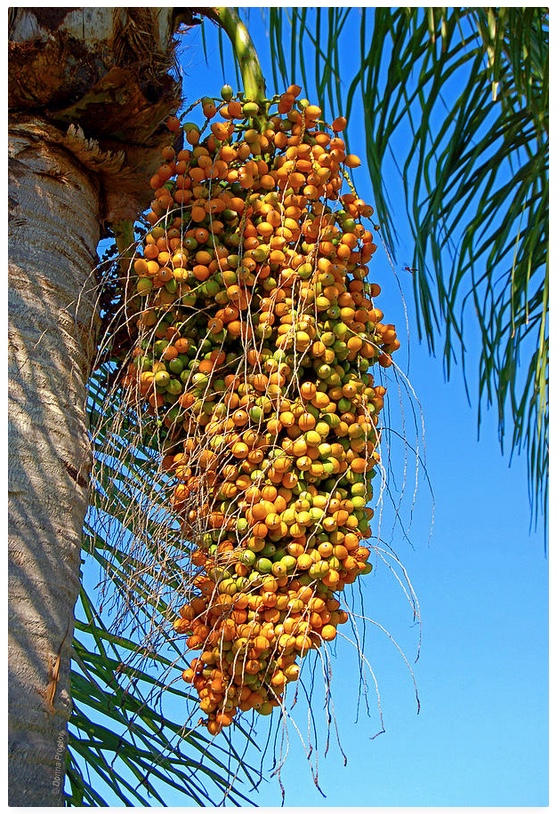
Florida Queen Palm. Photo by Donna Proctor
As you might expect one can forage locally all 12 months of the year. Still, plants have their seasons. This past weekend in West Palm Beach we saw an edible going out of season, a couple coming in, and one confused. Ringless Honey Mushrooms were on their way out. We found several bunches but they were past edible prime. Starting its season and mentioned in recent newsletters is Pellitory, or Cucumber Weed. It likes cooler weather and shade. The confused species was Spanish Cherry. It usually fruit mid-spring. But like many plants perhaps throw off by Hurricane Irma it was dropping a lot of unripe fruit in December. However, one species that was happily fruiting the Queen Palm.
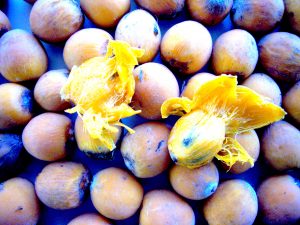
Queen Palm Fruit Are Tasty. Photo by Green Deane
Queen Palms and Jelly Palms are not difficult to tell apart … unless they hybridize, which they can do. But generally said the Queen Palm fruit start out green then turn to light orange then dark orange. The Pindo Palm fruit go from green to light yellow to dark yellow. This past weekend we found two Queen Palms fruiting and one was sweeter than the other. Their fruit is sticky sweet and the seed oil is edible, too. While most palms are indeed tropical some species can take the cold. The Pindo Palm can live in sheltered locations as far north as Washington D.C. Folks also like to think of cactus as warm-weather plants but they are native to 46 of the 50 states. Cactus are not native to Hawaii, Vermont, New Hampshire and Maine. Yes, cactus are native to Alaska. Back to the Arecaceaes, to read more about the Queen Palm go here.
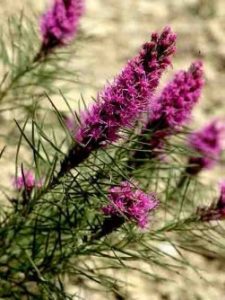
The edible Liatris punctata.
And now for a plant that is rarely mentioned: Liatris. I first learned about them as wild food in the book Edible Plants of the Gulf South. Before then I had been looking at them for about 30 years and didn’t know they were edible. I remember Dick Deuerling talking about the Liatris but I don’t remember him mentioning at the time that it was edible. Dick was the professor emertitus of foraging here in Florida and passed away in his early 90s four years ago last July. There are a couple of reasons to be excited about the Liatris. First, they are fairly easy to identify and where they do grow there’s usually a lot of them. What’s also interesting is that some experts think they can live for a century or more waiting for just the perfect conditions to flower, usually right after a forest fire. It seems the corm is dependent on fire to tell it when to send up a sprout. The species mentioned most often for an edible root is L. punctata. To read more about the Liatris go here.
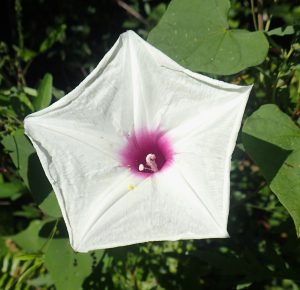
The Old Man’s Leg Morning Glory.
How to sort out Morning Glories while driving 60 MPH. When I see a blue Morning Glory blossom I ignore it. Usually nothing is edible about the plant though the seeds might be hallucinogenic. If I see a pink Morning Glory blossom it can go either way, usually not edible, but sometimes a famine food, same with a red blossom. If I see a small white Morning Glory blossom I ignore it. A local one, the Alamo Vine, has cyanide. But if I see a large white Morning Glory blossom or a large white Morning Glory blossom with a ruby throat I investigate it. Usually something is edible about the plant. It might be the blossom, leaves, root, or the entire plant depending on the species. For this discussion I would consider two inches across the petals and under small. Large is often three inches across and four to six inches long. With this rough guide you can from a distance glance at a Morning Glory blossom and know whether to look further. To read more about Morning Glories go here.

Foraging Classes are held rain or shine or cold.
Foraging Classes... are four hours long. This past weekend we had classes in Sarasota and West Palm Beach. Winter had not arrived yet though by this weekend it might be chilly. Fortunately this week’s class is in Port Charlotte. However, it is on the Peace River so it might be windy. Dress accordingly.
Sunday, December 10th, Bayshore Live Oak Park, Bayshore Drive. Port Charlotte. Meet at the parking lot at the intersection of Bayshore Road and Ganyard Street. 9 a.m.
Saturday, December 16th, Blanchard Park, 10501 Jay Blanchard Trail, Orlando, FL 32817. 9 a.m. Meet by the tennis courts near the WMCA building.
To learn more about the classes go here.

Green Deane DVD Set
All of Green Deane’s videos available for free on You Tube. They do have ads on them so every time you watch a Green Deane video I get a quarter of one cent. Four views, one cent. Not exactly a large money-maker but it helps pays for this newsletter. If you want to see the videos without ads and some in slightly better quality you can order the DVD set. It is nine DVDs with 15 videos on each for a total of 135 videos. Many people want their own copy of the videos or they have a slow service and its easier to order then to watch them on-line. The DVDs make a good gift for that forager you know especially on long, cold winter months. Individual DVDs can also be ordered or you can pick and choose. You can order them by clicking on the button on the top right hand side of this page (if your window is open wide enough.) Or you can go here.

Green Deane Forum
Want to identify a plant? Looking for a foraging reference? Do you have a UFO, an Unidentified Flowering Object you want identified? On the Green Deane Forum we chat about foraging all year. And it’s not just about warm-weather plants or just North American flora. Many nations around the world share common weeds so there’s a lot to talk about. There’s also more than weeds. The reference section has information for foraging around the world. There are also articles on food preservation, and forgotten skills from making bows to fermenting food. One special section is “From the Frightening Mail Bag” where we learn from people who eat first then ask questions later. You can join the forum by clicking on “forum” in the menu.

Keynote Speakers at the Florida Herbal Conference Linda and Luke Black Elk.
It’s time to be thinking about two conferences in February, Earthskills in Hawthorn, and the Florida Herbal Conference near Lake Wales. I lead plant walks at both events. Earthskills is Feb 7-11 and the Florida Herbal Conference is Feb 23-25. While the former organizes later in the year the Florida Herbal Conference is already accepting registrations. It is usually sold out so register early. Because you read this EatTheWeeds newsletter you get a discount for the Florida Herbal Conference. If you register between now and January 31 using the code FHC2018_GREENDEANE you can get a 30% discount. Keynote speakers this year at the Florida Herbal Conference are Linda and Luke Black Elk from the Standing Rock Reservation. Linda (of the Catawba Nation) is an ethnobotanist specializing in teaching about culturally important plants and their uses as food and medicine. She is a lecturer at Sitting Bull College in Fort Yates, North Dakota. Luke Black Elk (Thít?u?wa? Lakota) is a storyteller, grassroots activist, and traditional spiritualist. He has conducted research in water restoration, sustainable building design, and food sovereignty, and hopes to use these techniques to encourage a more traditional way of life among his people. Luke has lived on the Cheyenne River Sioux Reservation his entire life, becoming deeply involved in cultural and community activities. For more information about the Florida Herbal Conference go here.
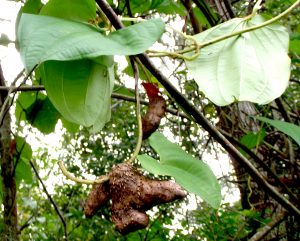
This true yam has a square stem and odd-shaped “potatoes.” Photo by Green Deane
One of my pet peeves is botanists who describe something as twining clockwise or counter clockwise. Why? Because I have two books describing the same vine, one says it twists clockwise and the other says it twists counter clockwise. Oddly they are both right even though they are also wrong.When a clock is on the wall, clockwise and counter clockwise is pretty easy to see. But when a vine grows up a tree it becomes a different matter. Why? Lets go back to that wall clock. What if it were a clear plastic clock on a glass wall. A person standing behind the clock would totally reverse what is clockwise or counter clockwise. In a phrase, clockwise or counter clockwise is a matter of perspective.
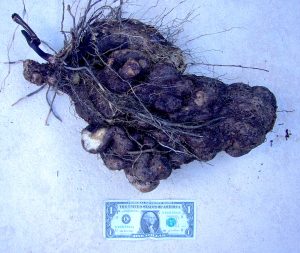
Dioscorea Alata root. Photo by Green Deane
If you look down at a vine it looks to climb one way. If you look up at the same vine, it appears to climb the other way. That is why I describe climbing vines at eye level, either lower left to upper right (the Z Twist) or lower right to upper left (the S Twist.) That would just be a bit of a blip in botanical minutia except it seems that vines that have the Z Twist often have edible parts and vines that have the S Twist do not. That’s an informal observation, not a rule or law. One genus that is exactly that way is Dioscorea, the yams. Not only am I picky about twist descriptions but I also have an issue with the genus name, Dioscorea. The Latin would have it DIE-oh…DIO-oh-score-ree-ah. But when you take into consideration the Greek physician it is named for is Dioscorides it would be THEE-oh-score-ree-ah, not DIE-oh. If that’s not confusing enough there are at least three versions of Latin pronunciation. Roman, British, and American. Pines are in the genus Pinus, said PINE-us on this side of the pond, penis, on the other side… And since I am on language…
 ZEFF. Z-E-F-F. Like the name JEFF but with a Z. That is how Greeks say their ancient god Zeus. Zeff got mangle into Zeus via Latin which couldn’t handle the Greek letter Y, or gamma. Depending on which letters it is paired with it can have an “f” sound or a “v” sound. The Romans ignore that and said things the way they wanted to. “Auto” comes to mind. In Greek it is “AF-toe.) An automobile is an afto-KIN-nee-toe, self-moving. Mangled and half borrowed in English it becomes automobile. If you have watched a few of my videos you know I am not keen on correct Latin pronunciations. Linnaeus chose Latin for when he was naming plants precisely because it was a dead language, meaning it is not evolving. (Then again Greek has changed less in 3,000 years than English in 300.) Still, a static language suited Linnaeus but has been a pain to the rest of us.
ZEFF. Z-E-F-F. Like the name JEFF but with a Z. That is how Greeks say their ancient god Zeus. Zeff got mangle into Zeus via Latin which couldn’t handle the Greek letter Y, or gamma. Depending on which letters it is paired with it can have an “f” sound or a “v” sound. The Romans ignore that and said things the way they wanted to. “Auto” comes to mind. In Greek it is “AF-toe.) An automobile is an afto-KIN-nee-toe, self-moving. Mangled and half borrowed in English it becomes automobile. If you have watched a few of my videos you know I am not keen on correct Latin pronunciations. Linnaeus chose Latin for when he was naming plants precisely because it was a dead language, meaning it is not evolving. (Then again Greek has changed less in 3,000 years than English in 300.) Still, a static language suited Linnaeus but has been a pain to the rest of us.
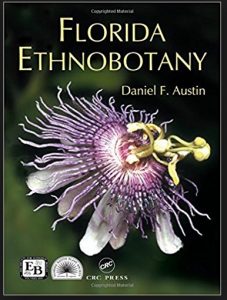
Florida Ethnobotany
The foraging world got by quite nicely for a very long time not knowing the Latin names of edible plants, or toxic ones for that matter. The most important thing is to identify a plant. The name is secondary unless you want to communicate with someone else far away. The scientific names of plants assure us that when we are discussing a plant we are talking about the same plant. There are 18 or so “Pig Weeds” in North America, some edible, some toxic. That’s where the scientific name becomes important, even if it is in Dead Latin. Dr. Daniel Austin in his 1,000 page book Florida Ethnobotany spends a lot of time on the native names of plants and their inclusion and change through various European languages. Looking at the language is worth the effort, particularly local names, because it often tells us how the plant was used.
This is issue 281.
If you would like to donate to Eat The Weeds please click here.


Right hand or left hand thread/helix is a reliable description
spanish cherry, mimusops elengi, is one that resembles peanut butter fruit, bunchosia argentea, but the leaves don’t have the silver undersides. it does taste like peanut butter!
Great and informative once again. ‘Had helped harvest the Large Prairie Liatris punctata seed recently.
Didnt know this much about it! Thank you!
Prickley Pear grows north into the Laurentian Shield area of Ontario, according to my Edible Plantsof Ontario book I took with me to the Atikokan base of the Boy Scout High Adventure camps in 1999. Didn’t find any on that trip, but did find much blueberry, miners lettuce, and other delights which have been forgotten over the years. The unrelenting sameness of the dried food/mystery meat meant my crew was pretty grateful for my foraging skills.